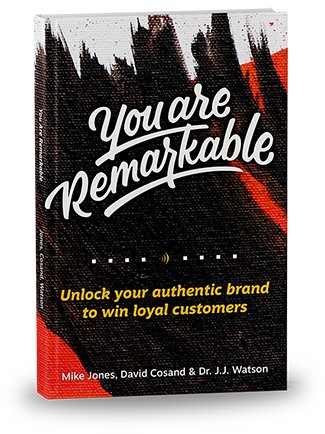Podcast: Play in new window | Download
Subscribe: RSS
 It’s tough for some companies to invest resources in building a great brand when they can instead spend money on making the next sale. And yet, if you ignore why you stand apart, you can be easily replaced. The question is not whether to brand, but rather how much, where and how? So let’s talk about the two stages of branding, so we can learn how to focus our efforts.
It’s tough for some companies to invest resources in building a great brand when they can instead spend money on making the next sale. And yet, if you ignore why you stand apart, you can be easily replaced. The question is not whether to brand, but rather how much, where and how? So let’s talk about the two stages of branding, so we can learn how to focus our efforts.
Note: As we learn what it means to deal with COVID-19, and as we watch to see what the economy will do, this is a great opportunity to talk about tightening things up. That doesn’t mean we stop operating. In fact, it can mean quite the opposite, but with more discipline. And to exercise discipline first means developing an understanding of what you’re dealing with. At no time are organization and optimistic sobriety more important than times like these. So this conversation lays a foundation to help us understand where branding leads. It’s the first step in understanding how to allocate your resources, spending precisely what you need on branding and marketing.
Branding and the Tough-Minded Business
Resound serves some of the toughest-minded, growth-oriented, business-to-business companies in the greater Phoenix area. They don’t suffer fools or indulge themselves in foolish spending. The difference is that these businesses also know what they’re about as people — that flows into their business, causing them to grow in sophistication. Because sophistication comes in the trenches, where you have to make real decisions about whether you’ll do what’s right or what’s expedient.
Businesses that don’t choose to do what’s right never develop the sophistication that comes from that experience. When you fail to avail yourself of each opportunity to do what’s right, you forfeit depth and strength of character. And it’s the same for companies as it is for individual people.
What We’ve Learned
Here’s what we’ve learned from our experience. I hope it helps you make sense of your situation. Branding comes under fire for being something that only the big companies can afford to do. Yet we can say from experience that our success has not made our clients undisciplined. They make bigger deals and work with better companies because they’re worth working with.
They care about money, and they care about operations. But they also care about doing it the right way. And they know how to talk about it in a way that makes them desirable to do business with. Because aside from the ethical problems, companies that don’t care about anything bigger than money or efficiency create for themselves a glass ceiling. They don’t know why they can’t get bigger deals or keep relationships.
It’s the companies with bigger values that see unlimited growth. They’re the ones who seem so generous and joyful, even in tough times. They’re the ones who come out of hard times stronger and usually with a larger market share.
So how do you measure it? If you’re still with me, you agree that branding becomes an outflow of your values and gives you something much bigger to offer the market. The next question is, how do you measure the effectiveness of your brand? After all, it’s one thing to define your values, and it’s another thing to see them inform, coordinate and align your entire culture to the point that everyone, even outside the company, feels the energy of the brand.
Two Primary Stages of Brand Effectiveness
Marty Neumeier talks about it as a ladder that starts with satisfaction, goes to delight, moves to engagement, and then leads to empowerment. Most B2B companies will be interested in the first two: satisfaction and delight.
Stage 1: Satisfaction
Satisfaction begins with fairness and trust. They’ve purchased from you and want to do it again.
- They get a sense of closure.
- You are able to inspire confidence.
- They enjoy a solid experience with you that feels complete.
Stage 2: Delight
When clients look for opportunities to endorse you. When customers are delighted, they don’t just return. They identify with you and actively tell people about you. They can’t wait to tell other people about you. They’re proud to have your sticker on their car or proud that they use tools from your company because it means they have legitimacy. This happens in B2B all the time because it shows you’re at a certain status.
So How Do You Make it Happen?
Great brands create a sense of direction within an organization that creates a sense of direction outside of the organization. If everyone in the organization understands what the company is all about, measuring success and serving customers in a consistent way, you now have what is the starting place for a brand.
What Branding Teaches a Culture
It teaches people that you stand for something great. Companies that only talk about money with their employees, in terms of overtime, cost savings, efficiency and things like that, teach their employees that the important things are financial and directly measurable. And if it’s measurable then it matters and if it’s not measurable then it doesn’t matter.
Branding, on the other hand, lives out those good values in relationships out there in the world, getting everyone focused on a cause that’s bigger…something you share with your audience.
What Branding Creates Within Your Company
When you care about money, but believe you get money NOT by thinking about money, but by helping others, it shows. Companies that care about money and care about making a lot of it, but also care about offering value and doing things that benefit other people, are able to align all those things. They align that desire to make a lot of money with an investment in their values.
But the opposite is true, too. To focus on your values creates distrust. You can tell when someone is just all about the transaction and the money, and you feel used.
All this reminds me of a quote I heard a while back.
You can have anything you want if you can help enough people get what they want.
-Zig Ziglar
The truth in this is that you, by being someone who cares about people and also cares about making a lot of money, can make those two things work together in your brand.
This is why it’s so important to define your company beyond just the money and those things that are easy to measure. Because if you can define your company by how it serves people, and if you can really make that your driving force — to where it feels tell your employees like it’s the driving force — then you’re on your way to a great brand that stands out from your competition.
Build Your Brand Premium
As real as a brand is, not everybody is willing to control it. It’s harder to measure than advertising because it’s the long-term result of a set of values and activities that are hard to measure together. And yet, you don’t want to be a commodity that’s easy to be replaced by your customers (or your employees, who might opt for greener pastures, for that matter).
Start with your values and personality — your brand — and build from your strengths. Aim for what advertising, by itself, can never give you: repeat customers who tell other people about you. No amount of Groupon-like, transactional offers that buy temporary sales can build very much momentum without the ability to execute your values consistently. But for those companies that want a higher ceiling and a firmer foundation, decide what you believe and how you work. And you’ll build the kind of momentum that will work with your sales and marketing efforts to build your business in the long term.
If you’re looking for more practical tips like these, consider signing up for our newsletter, registering for our next free video class, or subscribing to our book launch mailing list which will have tons of exclusive insights from our upcoming book.



